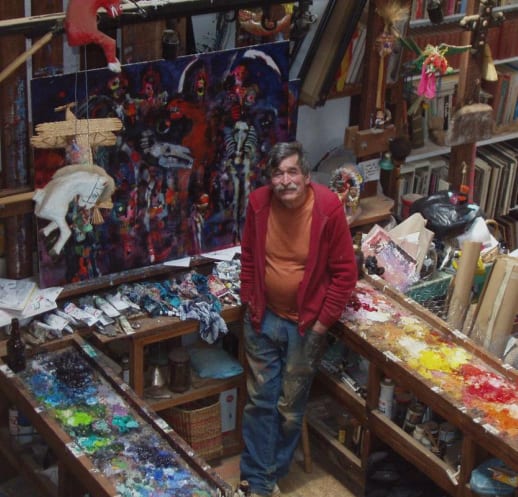Tom Hamil, like a great jazz musician, improvised continuously, feeling and thinking and creating at once. Spontaneous and fresh for decade after decade, his masterful touch was thrilling and deft, capturing life as it was being lived.
I don’t know how he did it, but he captured energy. His paintings give a live performance.
You register the zeitgeist of San Francisco’s Chinatown, not the look of an urban landscape.
I jog by his studio on Broadway and often stop to look at his front door with his paintings on glass panes. Each time the essence-of animals come to life. These are not depictions or symbols of animals, these are live totems.
I wrote the article, “Tom Hamil, Keeping the Beat,” for Ink Magazine in 2009:
Hipster–1940 to 1960 definers of “cool,” who knew the streets of San Francisco or jazz clubs of Harlem–called cats cuz they prowled—whiskers and night sight picking up ambiance sifted by intuition. Norman Mailer described them best in his essay, “The White Negro.”
That’s what Tom Hamil is. His self-described “color and movement are life” paintings are visual equivalents to jazz riffs. Sweating is allowed if it is a by-product of intense enjoyment, not intellectual effort.
Hamil is prolific. If something “interests” him, he does a preliminary sketch in heavy black ink that is about rhythm, making for stagey apparitions that are still tuning their forms, and shaking themselves dry.
In oil paint, the idea stays un-gelled, forcing the looker to get down and ‘Kinda Blue.’ It’s a two martini mind-shift, peering through a smoky cabaret before you’ll feel the rhythm coming up through the floorboards.
Leave your head but bring your street-smarts to Parisi Gallery for an urban immersion, where Hamil’s works will be showing until Oct. 10. Rio Bravo Fine Arts also keeps his work on display or on-hand.
Hamil is open to studio visits as well—call (575) 894-1181 to arrange one. It is located at 1310 S. Broadway in TorC.
Hamil studied at the California school of Fine Arts (which is now the San Francisco Arts Institute) in the late fifties.
He mixes his palette as he goes, letting the last stroke dictate the next. This now, now, now, existential attitude toward painting he learned from the Beats, he says.
“Color is the whole thing. It moves like music. The stroke dictates what comes next. It flows like a song. Each painting is its own little world. It evolves in itself.”
Tom’s wife, Reilly, sent a link to his obituary, published recently in SFGate:

